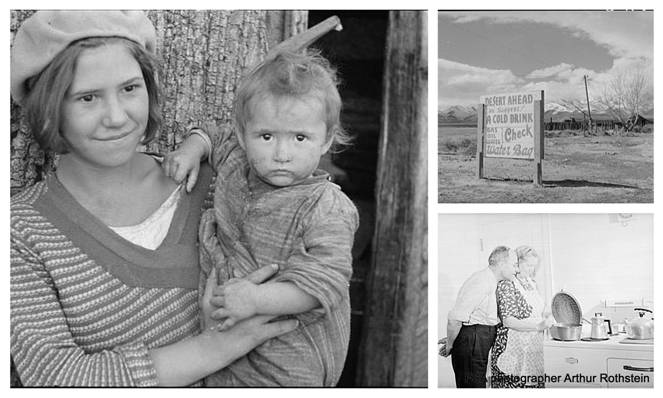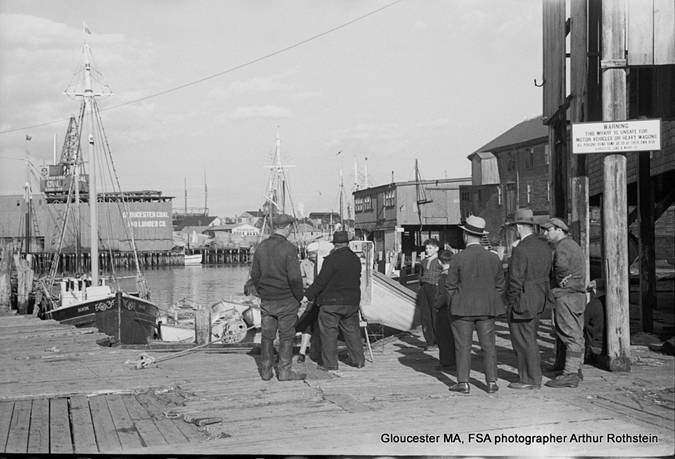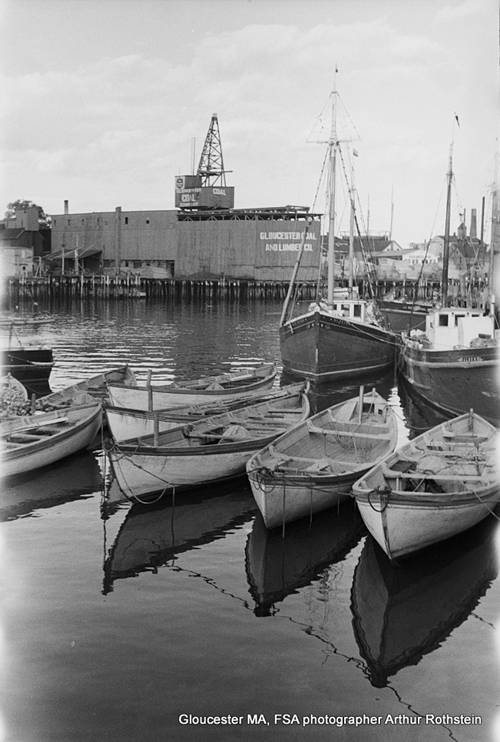Catherine Ryan Submits-
CROSS-COUNTRY CHRONICLE
Gloucester, MA in landmark FSA/OWI documentary photographs
Part 3
American Photographer HOWARD LIBERMAN
150 FSA/OWI photos in Gloucester, MA, September 1942
Hey, Joey,
Here is Part 3 in a series about Gloucester photographs in the legendary Farm Security Administration / Office of War Information (FSA/OWI) collection within the Library of Congress.
You can go back to Part 1 about artist Gordon Parks, and for some background about the program (1935-42).
Part 2 is about photographer Arthur Rothstein with a timeline and quick facts.
In 1942, the Farm Security Administration Historic Photographic section program was winding down as it transitioned and prioritized for WWII. It was temporarily folded into the Office of War Information before shutting down completely. (Gordon Parks was brought on board during this transition.) Director Roy Stryker was occupied with many directives including securing a safe haven for the FSA archives. He was also maintaining a network of contacts in the publishing world and private sectors, and writing. He contributed a chapter for Caroline Ware’s influential book, The Cultural Approach to History. There was magazine work such as the 1942 issue of The Complete Photographer which published articles by both Arthur Rothstein (“Direction in the Picture Story”) and Roy Stryker (“Documentary Photography”.)
Rothstein had already left the FSA. In 1940, Peter E. Smith Publishers, Gloucester, MA, produced his photo book, Depression Years as Photographed by Arthur Rothstein. This compilation of photographs included the best known Gloucester image from his 1937 visit; was it one of the publisher’s, too.
In 1941, Elmer Davis was appointed as the Director of the newly created Office of War Information (OWI). In 1942, Davis hired Francis Edwin Brennan from FORTUNE magazine to head the Graphics Department of the OWI.
As Art Director of Fortune (1938-1942), Brennan commissioned famous covers by artists such as Otto Hagel and Fernand Leger. He was known in the industry as a serious art and publishing expert and was a favorite of Henry Luce.
It’s likely that Brennan was one contact for Howard Liberman’s engagement at OWI. In August of 1941 Brennan featured a FORTUNE magazine special portfolio of sample posters to showcase the development and potential of this media. Howard Liberman was one of the artists he commissioned; here’s his contribution for that issue:
And here is a poster Liberman created for the OWI.
Liberman worked with color photography, too, which is a sub-collection at the Library of Congress, less known than the black and white. Color photography was available, but more expensive to process and for media publishers to print.
Howard Liberman was dispatched to Gloucester in September of 1942. His photographs show a clear emphasis on WWII dominant coverage, sometimes with an FSA take. The titles on Liberman’s OWI photos often lead with a heading. For Gloucester, many images have caption leads that begin with the patriotic category: VICTORY FOOD FROM AMERICAN WATERS.
In Gloucester, Howard Liberman spent a time on the docks and out with the crew of the OLD GLORY.
His captions seldom include surnames of the portrait subjects. They do have lengthy– sometimes general, sometimes quite specific– descriptions to support the category heading.
There are action and portrait shots of the crew catching rosefish during an Old Glory voyage.
“Victory food from American waters. At the docks in Gloucester, Massachusetts, crew members prepare their trawler for a week’s voyage. Most of the fishermen in the city come from a line of fishermen that dates back for centuries.”
“Victory food from American waters. Immediately after being caught rosefish are shoveled into the hold for packing the ice. Once called “goldfish” because of their brilliant color, the fish are finding a ready market because of their manifold uses–as food for humans, as fish meal and fish oil.”
“Crew members throw overboard excess ice from Old Glory’s hold. Fishmen allow a proportion of one ton of ice to three tons of fish. When the catch is unusually large as on this trip, some ice is removed to make room for the fish.”
“Victory food from American waters. Decks are covered with tons of rosefish as the Old Glory reaches its capacity load. After two and one half days of fishing, a catch of 85,000 pounds has been hauled in”
“Tomorrow’s fishermen–young Gloucester boys push wagons of rosefish from the unloading pier to the processing plant where the fish are filleted and frozen…Many of the boys will follow their forefathers and fishermen in New England waters”
Look for ‘scenes’ such as Captain John Ribiera (surname spelled a couple of ways in the archive) at work and with his wife at home. 1942 census indicates “Oscar (Irene) fishermn Riberio” at 18 Perkins Street.
Note the picture of “the Pilot at the Wheel” above the stove
Another reminder to look for exhibits to see vintage prints in person, rather than the low resolution files I’m showing here. Various resolution options are available at the Library of Congress. Besides the formal details, check out the Captain’s eyes!
Binnacle blinded.
The “Mother of Good Voyages” statue in Captain John Riberia’s quarters on the fishing trawler “Old Glory”
There are a couple of Gloucester interiors (deteriorated negatives) of the Gloucester Mariners’ Association; they infer “captains welcome only.” One shows a gentleman playing cribbage; another shows Captain Ben Pine, the man who raced the schooner Gertrud Thebud.
Joey, beautiful dangerous industry: shoveling fish into the rotary scaler at a fish packing plant.
For assignments in other towns, typical headings for Liberman categories include:
Americans All; Subcontracting; School Boys in Training; Industrial Safety; Office Equipment Used by WPB; Women at War; Fuel Oil Consumption; Women Workers (see below making flags); Airports (ditto other industries); Military (e.g. Fort Belvoir); African American Aircraft Propeller Workers (ditto other jobs); Shipyard Workers; Bomber Plant Workers; Price Control; Production; Submarine Chasers; and Conversions (from this to look here it is now was a useful WWII product)
There are more than 50 additional Gloucester photos in the Library of Congress collection, and one Royden Dixon image from 1940.
We are fortunate that so many talented artists worked on the FSA/OWI project, that a few visited Gloucester, and that so many folks across the county were willing to participate as subjects (easier during the War)
The municipal employees and the curators and staff who have worked on these collections (over decades) are superstars. Beverly Brannan is the curator of 20th C documentary photography at the Library of Congress.
For the FSA/OWI program, Director Roy Stryker proselytized that photography was perhaps the best tool for analyzing living history. He felt that photography as a fine art form and its gains in technical ease and advances coincided ideally with the timing of the FSA/OWI historical photographic section. He forecast rapid and constant increase in photography use and adapters. He was inspired by individual and private pioneering antecedents (Brady/Civil War, Hines/Russell Sage), and public ones such as the documentary photographs by William Jackson for the Department of the Interior.
Sometimes I think of Stryker’s Section work along a continuum of government spending on exploration that produced great contemporaneous historical records. The journals of Lewis & Clark. The work created by artists who participated in the NASA Art Program. These FSA photographs.
Stryker realized that there were collections of photography building up in municipalities big and small; how they were catalogued and assessed were critical to their use. Here in Gloucester, the Cape Ann Museum maintains a Historic Photo Collection containing over 100,000 images from 1840s through now. Photography is included among its permanent and temporary exhibits and what’s not on view can be researched at their archives.
GLOUCESTER PHOTOGRAPHY PRE, DURING AND POST FSA/OWI
There were many independent artists as well as staff photographers (local newspapers, businesses such as Gorton’s, etc.) working in photography here in Gloucester. Every decade has wonderful examples such as Herbert Turner, Alice Curtis (and other photographers that Fred Bodin features), and David Cox’s father, Frank L. Cox.
There were numerous visits from staff photographers of major publications like Life, Vogue, National Geographic, and more. Gordon Parks came back at least two more times; a few other celebrated staff photographers that came through include Luis Marden, Eliot Elisofon, Yale Joel, Co Rentmeester and Arthur Schatz.
No- photographic artists who also worked in photography is another long list, and would include Leonard Craske, Emil Gruppe, Philip Reisman, and many others.
Good Morning Gloucester features photography, that’s for sure.
-Catherine Ryan / all photos Library of Congress, FSA/OWI black and white photography collection









































